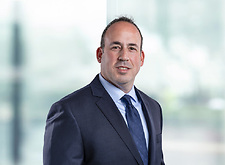New York Unveils Roadmap to 70 Percent Renewable Energy by 2030
On June 18, 2020, NYSERDA and New York State Department of Public Service Staff (“DPS” or “Staff”) released a much-anticipated White Paper describing how the State can reach the Climate Leadership and Community Protection Act’s (“CLCPA”) target of having 70 percent of electricity consumed in New York come from renewable generation by 2030 (referred to as the “70 by 30 Target”), and a zero-emission electricity grid by 2040.[1] According to NYSERDA, only 26.8% of New York’s electricity demand was met with renewable resources in 2018, most of which was in-state hydropower. This White Paper lays out the policy and regulatory steps needed to drastically increase that number and, in the next ten years, transform the electricity system of the world’s 11th largest economy.
Watchers of the State’s energy policy and markets have eagerly awaited this proposal to understand the State energy team’s thinking, for example, on opening the door for significant hydropower capacity from Canada, an offshore wind procurement schedule, repowering existing renewable energy facilities, compensation for legacy “Tier 2” facilities, alignment with New York City’s landmark “Local Law 97” (which requires a massive reduction in carbon emissions by the City’s building stock), the projected costs of the CLCPA’s directive, and a slew of other market-moving considerations. With these proposals and analyses now on the table, DPS will soon notice the White Paper for at least a 60-day comment period, and likely later this year the New York Public Service Commission (the “Commission”) will issue an order that will change New York State’s electricity markets for decades to come.
I. The CLCPA’s 70 by 30 Target
The CLCPA, signed on July 18, 2019, directed the Commission to establish a program requiring that: (a) a minimum of 70 percent of the state wide electric generation secured by jurisdictional load serving entities to meet the electrical energy requirements of all end-use customers in New York state in 2030 be generated by renewable energy systems; and (b) that by 2040 the statewide electrical generation system will produce zero emissions. The CLCPA also directs the establishment of technology-specific programs, including the deployment of six gigawatts (“GW”) of distributed photovoltaic solar generation by 2025, three GW of energy storage resources by 2030, and at least nine GW of offshore wind by 2035.
The CLCPA also sets a statewide goal “to reduce greenhouse gas emissions from all anthropogenic sources 100% over 1990 levels by the year 2050, with an incremental target of at least a 40 percent reduction in climate pollution by the year 2030.”
The White Paper proposes to use the existing regulatory and procurement structure established under the Commission’s 2016 Clean Energy Standard (“CES”) Order, which implemented the State’s 2015 Energy Plan to require 50 percent of electricity used in New York by 2030 be generated from renewable sources, to meet the now-increased CLCPA target of 70 by 30.
II. Quantifying How Much Renewable Energy Will Be Needed
The White Paper forecasts the statewide electric load in 2030 to be 151,678 gigawatt-hours (“GWh”) of wholesale energy requirements, meaning that New York will need 106,174 GWhs (70 percent) of renewable energy to meet the CLCPA goal. The 2030 load estimate factors in anticipated increased electricity demand due to electrification of buildings (10,334 GWh) and electric vehicles (9,048 GWh), as well as reduction of load because of energy efficiency measures (40,865 GWh). NYSERDA and Staff expect that the New York Power Authority (“NYPA”) and Long Island Power Authority (“LIPA”) – the State’s largest “non-jurisdictional load serving entities” – will participate in the 70 by 30 Target, subject only to minor modifications. The Table shown here illustrates how the anticipated contributions will add up to 70 percent.
III. Ramping up Tier 1 REC Procurement
- Eligible Technologies
The CLCPA defines “renewable energy systems” to mean “systems that generate electricity or thermal energy through use of the following technologies: solar thermal, photovoltaics, on land and offshore wind, hydroelectric, geothermal electric, geothermal ground source heat, tidal energy, wave energy, ocean thermal, and fuel cells which do not utilize a fossil fuel resource in the process of generating electricity.”
Because the CLCPA’s definition omits biomass in all forms and non-renewable powered fuel cells, NYSERDA and Staff propose in the White Paper to amend those CES definitions to exclude such technologies. Though the CLCPA includes hydroelectric power as a renewable resource, Staff and NYSERDA recommend in the White Paper keeping the CES’s narrower definition for Tier 1, which limits hydroelectric eligibility to low-impact run-of-river projects and upgrades to existing facilities without new storage impoundments. Given the significant negative impacts associated with large-scale impoundments, this directive is consistent with state environmental policy. - Increasing Tier 1 Procurements by 40%
Assuming a 20% attrition rate for selected Tier 1 projects, the White Paper projects that NYSERDA will need to average almost 4,500 GWh of Tier 1 REC procurements annually over the 2021 to 2026 period in order to meet the 2030 Target. This constitutes a roughly 40% increase over recent procurement levels. According to these projections, to meet the State’s goals NYSERDA must contract for 24,990 GWh from new Tier 1 resources beyond those already procured, and do so by 2026 to ensure the projects’ operation by 2030.
Recognizing this means massive procurements, Staff and NYSERDA acknowledge that NYSERDA should have the flexibility to respond to market conditions and procure more or less in a given year. Rather than conducting make-up solicitations to meet minimum annual requirements, the White Paper recommends that NYSERDA be permitted to adjust for any shortfall in subsequent solicitations. To keep attrition in check, NYSERDA should be empowered to reject non-viable projects early in the evaluation process, rather than giving them a lower score as is current practice.
IV. Annual Procurements for Offshore Wind
To date, NYSERDA and LIPA have executed contracts for 1,826 MW of offshore wind. In April 2020, the Commission approved NYSERDA’s petition to conduct a 2020 solicitation for at least 1,000 MW of offshore wind renewable energy credits (“ORECs”), with flexibility to accept bids up to 2,500 MW. See prior alert here.
Including the upcoming 2020 solicitation, approximately 7,200 MW remains to be procured to meet the CLCPA’s nine GW target by 2035. As for the 70 by 30 target, NYSERDA also anticipates offshore wind comprising over 17 percent of New York’s load by 2030, with new, yet-to-be contracted projects accounting for around 12 percent. Accordingly, the White Paper proposes a procurement schedule – a market signal long sought by the offshore wind industry – for ORECs that averages between roughly 750 MW to 1,000 MWs annually through 2027. As with Tier 1 RECs, NYSERDA would have authority to adjust the timing and amount of solicitation to respond to market conditions.
Finally, this White Paper proposes the development of a feasibility study assessing the potential of offshore wind in the Great Lakes, primarily in relatively shallow Lake Erie. While the consideration of this infrastructure will no doubt be controversial, wind development in the Great Lakes, if feasible, could also play a key role in New York’s path to a diversified clean energy economy.
V. Tier 4: A New Tier for New York City-Deliverable RECs
Recognizing the difficulty of meeting the 70 by 30 Target given the upstate/downstate transmission constraints, and the significant differential in the cleanliness between the upstate and downstate electricity systems, the White Paper proposes a new Tier 4 of RECs within the CES to facilitate the delivery of additional renewable energy into Zone J (New York City and parts of Westchester). Applicants must locate a utility-scale eligible resource directly in Zone J, or demonstrate that the eligible resource will be delivered directly into Zone J using a new transmission interconnection.
The White Paper recommends that the Commission grant NYSERDA authority to procure environmental attributes for up to 3,000 MW of Tier 4 resources, through one or more solicitations. All load serving entities ("LSEs") would be responsible for procuring Tier 4 RECs in proportion to the amount of retail load served, since Tier 4 RECs would be in furtherance of the CLCPA’s statewide 70 by 30 target.
- Eligibility
In addition to Tier 1-eligible resources, Tier 4 would be open to a broader set of hydroelectric resources. To qualify for a Tier 4 REC, hydroelectric resources must (i) not come from any hydropower impoundment not already in existence or under construction as of June 18, 2020, and (ii) be additional to the supplier’s baseline production. The latter “additionality” test would consider whether the associated energy exceeds the amount of energy the supplier has historically delivered to New York, and whether such energy represents a net increase in the supplier’s total renewable energy generation as compared to a baseline. Suppliers would need to provide detailed historical data and consent to the use of any tracking system and/or auditing regime that may be necessary to verify compliance.
This definition could potentially accommodate Canadian hydropower delivered through the proposed Champlain Hudson Power Express (CHPE) transmission line. Instead of a specific carveout for CHPE or deeming all hydropower renewable, the White Paper creates a competitive market where CHPE-transmitted Canadian hydro will have to demonstrate its additionality and renewableness, but also have to compete against other transmission projects and in-zone resources. Tier 1 resources interconnected directly from upstate via transmission lines in development, as well as offshore wind projects connecting into Zone J would be eligible to submit competing bids in a Tier 4 REC RFP.
NYSERDA would have the authority to solicit both Fixed and Indexed REC bids under Tier 4, using more or less the same methodology described in the Commission’s Index REC Order. As under Tier 1, NYSERDA would compare Fixed and Index REC bids on a levelized net cost basis in evaluating the price criterion. Tier 4 largely would follow the same solicitation and contracting process established for Tier 1, subject to a few minor differences. - Interaction with New York City’s Local Law 97
Tier 4 RECs delivered to Zone J may be eligible for compliance with New York City’s Local Law 97. Enacted on May 18, 2019, Local Law 97 of 2019 imposed binding limits on the emission of greenhouse gasses from major buildings in New York City, beginning in 2024. This law applies to industrial, institutional, commercial and residential buildings in the city with more than 25,000 gross square feet of floor area, and aims to reduce building-based emissions 40% by 2030 from a 2005 baseline.
Local Law 97 authorizes the use of RECs delivered to Zone J as an alternative means of compliance. According to the White Paper, NYSERDA should be allowed to resell the Tier 4 RECs it procures through an open offer in which any purchaser, including Local Law 97 compliance entities, may participate. DPS and NYSERDA seek comment on whether such offers should be subject to an additional price floor based on the social cost of carbon, and what should be done with any excess funds from the re-sale of Tier 4 RECs.
VI. Maintaining and Repowering Existing Renewable Resources
On January 24, 2020, NYSERDA filed a petition proposing a Competitive Tier 2 Program for baseline renewable generation, i.e., non-state-owned run-of-river hydropower and wind generators that entered commercial operation prior to January 1, 2015. Maintaining the New York’s existing fleet of renewable resources that comprise the current baseline is part of the State’s strategy for achieving the 70 by 30 goal. Though that petition remains pending, the White Paper seeks comments with respect to NYPA’s participation under the proposed Competitive Tier 2 program, and its role, if any, in procuring Tier 2 RECs.
The White Paper also proposes that the Commission amend the requirements for repowered facilities to be eligible for Tier 1, specifically allowing the facility’s entire production to become Tier 1-eligible at the end of the initial useful life.
VII. Cost Projections
NYSERDA estimates that the proposed Tier 1 procurements and incremental offshore wind procurements would have a levelized impact on electricity bills of less than 0.5% and 1.1%, respectively. This translates to $0.35 and $0.81 per month for the typical residential customer. Taking into account the value of the avoided carbon emissions, these procurements are estimated to yield a net benefit of almost $7.7 billion (Tier 1) and $9.6 billion (offshore wind) over the lifetime of the projects. These figures do not include the substantial economic value and health benefits of reducing local air pollution, which would likely push the net benefit even higher.
The White Paper also proposes to combine the NYSERDA’s administrative funding for all programs (CES Tiers 1 through 4 and ORECs) be combined into one comprehensive annual funding request. NYSERDA anticipates the 2021 administrative fees for these programs, including the yet-to-be approved Competitive Tier 2 and Tier 4 programs, to total around $28.5 million.
VIII. Next Steps
The Department of Public Service will soon notice the White Paper for at least 60 days of public comment, during which time Staff and NYSERDA will also likely host technical conferences and other informational sessions regarding the proposals contained in the White Paper. After that public process, and including any time for reply comments – which is likely given the substantial nature of the White Paper’s proposals and likelihood of significant comments – the Commission will issue an Order. That Order, potentially to come before the end of the year, will set the stage for a new renewable energy ecosystem in New York State.
Please contact Noah Shaw (518.736.2924), Dan Spitzer (716.848.1420) or Peter Ross (646.218.7528) of the Hodgson Russ Renewable Energy Practice for more information about this matter.
[1] PSL §66-p(2)
Featured
- Partner
- Partner
- Partner
- Partner
- Partner
- Partner
- Partner
- Partner
- Senior Associate
- Partner
- Partner
- Co-Chair of the Firm, Partner
- Partner













